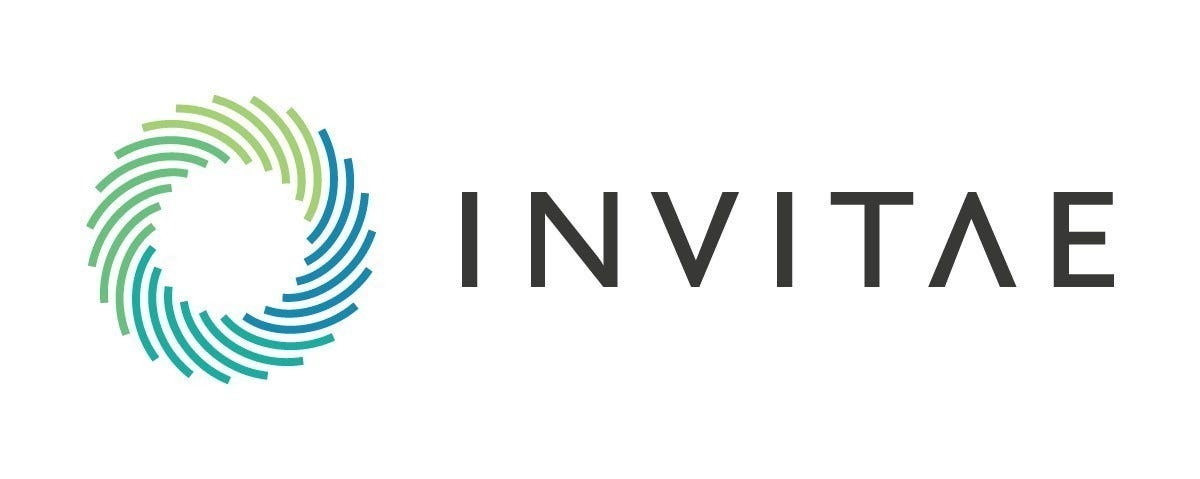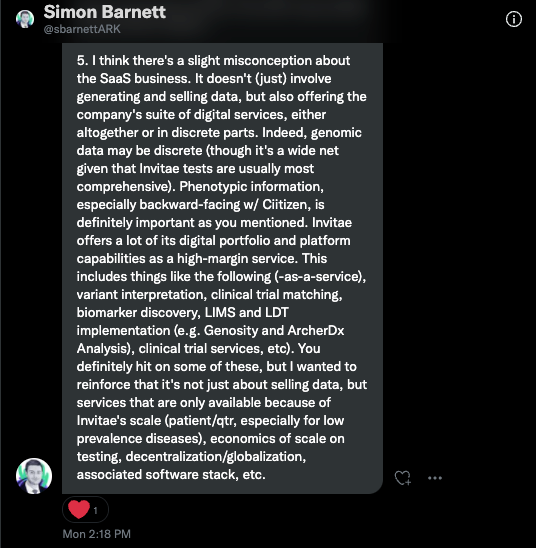Invitae: Challenges and competitors — Navigating the genomic testing space
Part 2 — Bear case on Invitae and why market dominance is not guaranteed
Hi friends 👋
Welcome to Health & Wealth — your weekly source of the latest health research and biotech trends. Many of you are new here, after reading part 1 of my Invitae deep dive last week. For you truth-seeking individuals, here’s the second part. If you are new, you can join here and share within your network — word-of-mouth is how I grow.
Last week, I published the bull case on Invitae NVTA 0.00%↑. In case you missed it, I highly recommend you read that before you scroll further here.
The bull case is built on the conviction that delivering genomic information is a winner-take-most industry. Bulls believe the market will eventually consolidate, and when that happens — Invitae is well-positioned to gain the lion's share of the future market.
Today, let's turn our attention to the bear case and what the bulls may be missing.
The bear case against Invitae
Here are reasons why the winner-take-most outcome may not pan out for Invitae:
Market dominance is not guaranteed. Lower pricing doesn’t wipe out competitors and labs struggle to differentiate themselves in consumers’ eyes.
It’s unclear what Invitae’s database exactly consists of (that’s not open-source), why it's valuable, and how it will be monetized.
Invitae is a historically high cash burn, highly dilutive company which stunts shareholder returns.
Taking a closer look at each:
1. Market dominance is not guaranteed. Lower pricing doesn’t wipe out competitors and labs struggle to differentiate themselves in consumers’ eyes.
Challenges are abound for Invitae’s “go for broke” strategy. This piece by @GenomicsCow articulates several. I will amplify a few points:
Invitae’s strategy to push out the competition by offering lower-cost testing hasn’t played out. Many companies have caught up — growing their volumes and reducing their cost of tests, too.
To truly create a monopoly in this space, a company needs to control distribution. Ways to get to that include getting closer to the customer. Create product stickiness and brand recognition. This is — if a provider, individual, or third party (payor, researcher, health plan, etc.) wants genetic insights, the first thing they think of is “Invitae.”
But today, that’s 100% not the case. Patients don’t recognize lab names — they’re all the same in their eyes. They just go with whatever their provider orders for them.
As for the institutions and insurers — the dominant proportion of payers — loyalty is often attached to low prices. For example, Myriad’s market in hereditary cancer started eroding after cheaper options from Invitae and others emerged:
Invitae can’t win in the long run with cheap tests alone. To make an analogy, Apple commands high margins and a disproportionately large market share of phones because of customers’ loyalty to their brand. Others like Samsung or LG are left fighting over customers with pricing and specs.
There hasn’t emerged an Apple of genomics. (Not counting 23andme here because they’re not clinical testing, although they arguably have the best brand recognition.)
The bottom line: Selling below cost is not sustainable. Simultaneously, little has fundamentally changed about how labs reach customers — a crucial component to achieving market dominance no one has seemed to crack yet.
2. It’s unclear what Invitae’s database exactly consists of (that’s not open-source), why it's valuable, and how it will be monetized.
I keep seeing arguments about how valuable Invitae’s dataset is, with some valuing the data alone to be $1-2 billion.
But there’s a lack of clarity on what data they’re actually referring to:

I haven’t found satisfactory answers to these sets of questions from either an analyst or Invitae themselves.
It’s certainly not variant interpretation (how genetic variants are classified, from pathogenic to benign). Most of that is open-source information and Invitae is the largest contributor. If anything, they’re subsidizing and benefiting others more than themselves here.
But okay, let’s play along. Invitae has over 2.5 million patients with over 62% available for data sharing. What does that actually mean?
There are primarily two types of data they could collect (and not share publically): genomic and clinical data. There are limitations with each:
Genomic data: likely patchy
It’s unclear how much of the genomic data Invitae has can be reused. Whatever genomic data they’ve collected, it’s likely patchy.
Won’t get too into the weeds here, but essentially it’s not clear whether they’re running sequencing panels only (picking out only specific genes needed for a report) or whole exomes for everything (reading all the genes that code for proteins).
Based on private conversations, it appears they run the entire “clinical area” for every test that is ordered. So if you order a cancer gene panel, Invitae is sequencing all cancer genes for which they offer testing and “masking” the un-ordered genes in reports.
What that practically means is that Invitae collects genomic information based on specialty. So let’s say you sought out cancer genetic testing. If Invitae were to use your sample for another clinical area, like cardiovascular disease or fertility, the genomic data they collected from you probably wouldn’t be as helpful.
Invitae appears to be running sequencing panels only. This means the data collected is likely lacking and inconsistent. Patchy data reduces the power of the dataset they’re amassing. It’s like only having a few scattered puzzle pieces in hand, but not the completed puzzle.
A quick note on genomic data collection: Invitae is also aiming to get over 1 million whole genome sequences (reading the entire genome) a year through a partnership with Pacific Biosciences. I’m not sure when that might materialize or how it could impact patients.
Clinical data: limited to no longitudinal data
The holy grail in population genomics is to get comprehensive genomic data paired with rich, longitudinal clinical data.
But it’s unclear how much clinical data Invitae is getting with each sample. They might get snippets of the patient’s medical and family history, but it’s far from complete. What’s more — the data isn’t longitudinal. There’s rarely any follow-up after the patient receives results.
Their recent acquisition of Ciitzen is a move to solve this issue which I’ll cover in another post.
How will the data be useful and monetized?
There are some monetization paths I can think of, but I have no sense of how useful or successful they could be:
Sell their data to pharma companies to identify potential drug targets or clinical trial patient candidates.
Help entities generate their own data by providing Invitae’s scalable technology stack as a service to sequence and analyze genomic data.
Test patients once, reanalyze many times by offering whole genome sequencing to patients and reanalyzing it throughout their lifetime.
Some argue that path #2 to offer digital services is a high-margin opportunity:
I’d like to see specific case examples of how data will be generated/used or how Invitae’s services will be useful. I’m giving them the benefit of the doubt and would be curious what they share on Technology Day in the spring.
The bottom line: I’m curious and a bit confused when people say Invitae’s moat lies in their database. If Invitae plans to use the collected data as a revenue-generating asset, they need to articulate their vision and validate it. Right now there’s no vision communicated.
3. Invitae is a historically high cash burn, highly dilutive company which stunts shareholder returns.
Many have already talked about this point. Tl;dr —
Invitae burns more cash than it has generated in revenues
High cash burn means more capital raised/loans taken and thus dilution by increasing share count
Dilution means Invitae could be making more money, but the stock price won’t grow as fast
My hot take is that while this is the most cited concern from bears, it’s also short-sighted and ignores other fundamental risks that could jeopardize Invitae’s long-term chances of success. See points #1 and #2.
Management also seems unfazed and expressed they can choose to dial down cash burn to move towards profitability:
“We have zero concern about COGS [cost of goods sold]... We could pull back investment on launching new stuff and we could drop COGS dramatically, it’s just how we allocate our R&D. Balancing it can be tough, but in general, 50% is what we target and we’ll get there very soon.”
[MedTech Innovations Summit: Sean George]
The big picture
Overall, Invitae has already proven itself as a leader in the genomic testing space. Genetic information is no longer scarce, but abundant and accessible — in large part thanks to Invitae. I admire their willingness to continue pushing the envelope, rather than just offering tests that support medicine as it was.
At its current discounted valuation, I see this as a potentially attractive long-term investment with tremendous upside. They’ve achieved cost-effective genetic testing at scale. They also invested heavily into building an ecosystem that’s all-encompassing —adaptive to the fast innovation cycles in genomics.
However, Invitae’s long-term market dominance is far from guaranteed. We are still in the early innings. Investors should also avoid falling prey to tech-speak waffle on datasets and network effects.
Thank you to @sbarnettARK, @InvestingPlug, @GenomicsCow, @PhanLawyers — and fellow genetic counselor colleagues @carrie_haverty, @EmilyFassi, @rawanawwad, and Gina Davis for feedback on an earlier draft of the Invitae series.
This bull and bear case on Invitae took way longer than anticipated. Paradoxically it’s harder to write about my home turf — clinical genetics — perhaps because I want to do it justice.
What am I wrong about or what might I have missed? I write to learn and sharpen my thinking, but also to invite others to correct my blindspots.
Enjoyed my two-part deep dive on Invitae?
Please let me know by hitting the ❤ button. It makes my day to see whether my readers like the content (it really does!)
Consider sharing this series with your network and subscribe for more from me:
Happy Lunar New Year! May the Year of the Tiger roar 🐅
Christina









excellent. balanced
Wow, such arrogance from Invitae management regarding reducing cash burn, lol. If anything, dialing back expenses to Invitae's magnitude is hard, very hard. This requires a culture change. And culture change is one thing that can topple a company if not done right.